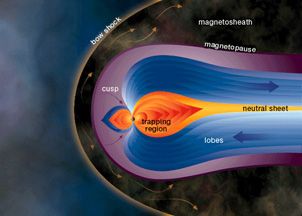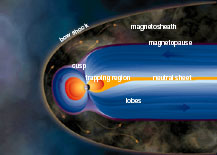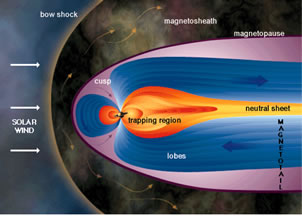Click on image for full size
Windows to the Universe original artwork
Magnetic Fields Near Planets
A magnetometer is an instrument for measuring magnetic fields. Many spacecraft carry magnetometers to measure the magnetic fields around planets. When a spacecraft makes those measurements, what do the measurements tell us?
The planet might have one big magnetic field covering the whole planet. Earth does, which is why we can use compasses to figure out which way is North. Mercury, Jupiter, Saturn, Uranus, and Neptune all have global magnetic fields too. Each of those planets has an area inside it that is a good conductor of electricity. Their magnetic fields are caused by the flow of electricity in the conductor.
The planet might have smaller magnetic fields around part of the planet. Maybe the planet had a strong magnetic field when it was young. Some of the planet's rocks might still have that magnetic field "locked into" them. Mars and Earth's Moon have magnetic fields locked into their rocks. A magnetometer might also show the location of large deposits of ores such as iron. Ore deposits could even be the remains of an asteroid that struck the planet!
The spacecraft also might detect magnetism caused by the solar wind or the Sun's magnetic field. The Sun's magnetic field is very strong. The spacecraft's magnetometer might detect the Sun's field even when the spacecraft is near a planet. Charged particles from the solar wind can also become trapped within a planet's magnetosphere. Particles moving around in the magnetosphere can also produce magnetic fields.
Finally, the magnetic field detected by a spacecraft might have two or more causes. For example, let's look at Earth. The magnetic field near Earth is partly caused by Earth's overall magnetic field, by charged particles racing around Earth's magnetosphere, and by other factors.














